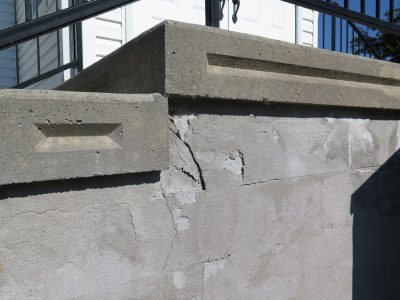Q: What’s the best way to fix the cracked parging on my house foundation? I live in a 13-year-old brick bungalow, with about 6 feet of parged concrete block foundation visible above ground. Over the years this parging has become messy looking, with faint concrete block lines and damp spots showing through. It’s ugly. Can parging be replaced? Is this a good idea? How much would it cost?

A: Parging is a thin, plaster-like coating of cement-based mortar that’s often applied to exterior blocks and other foundation walls to make them look better and, supposedly, last longer. Trouble is, parging usually starts to look pretty bad in a short time. The symptoms you describe are actually quite mild compared to how bad things can get with some parged block walls. It’s very common to see large flakes of mortar falling off, and it’s only a matter of time before this happens at your place.
The good news is that your situation isn’t that bad yet, so a good-looking, remedial repair is definitely possible. The first thing to understand is that moisture is the enemy. It soaks into some types of masonry and freezes in winter, causing mortar, brick and block to crumble and flake. Since this sort of mechanical damage hasn’t yet happened to your house, prevention is the best course of action.
Although you could treat the parging with an industrial strength, breathable masonry water repellent, paint would look better. In your particular situation, the foundation wall is large and it plays an important visual role in your home’s appearance. Exterior paint, especially breathable 100% acrylic latex formulations, are very durable, effectively sealing out liquid moisture and hiding the block lines and dark spots you describe. I’d pressure wash your wall first, let it dry, then brush on two or three coats of the highest quality, breathable exterior latex you can find. Ordinary paint can hold moisture in the parging if it gets in through cracks and gaps. Breathable paint, by contrast, helps keep liquid moisture out, but allow absorbed moisture to escape from the wall, if it does get that far.
If in time the parging starts to flake off (like the example in the photo above) I recommend not trying to repair the parging or replace it. Remove all the loose parging, then simply keep the block wall painted. I’ve never seen a situation where parging didn’t do more harm than good.